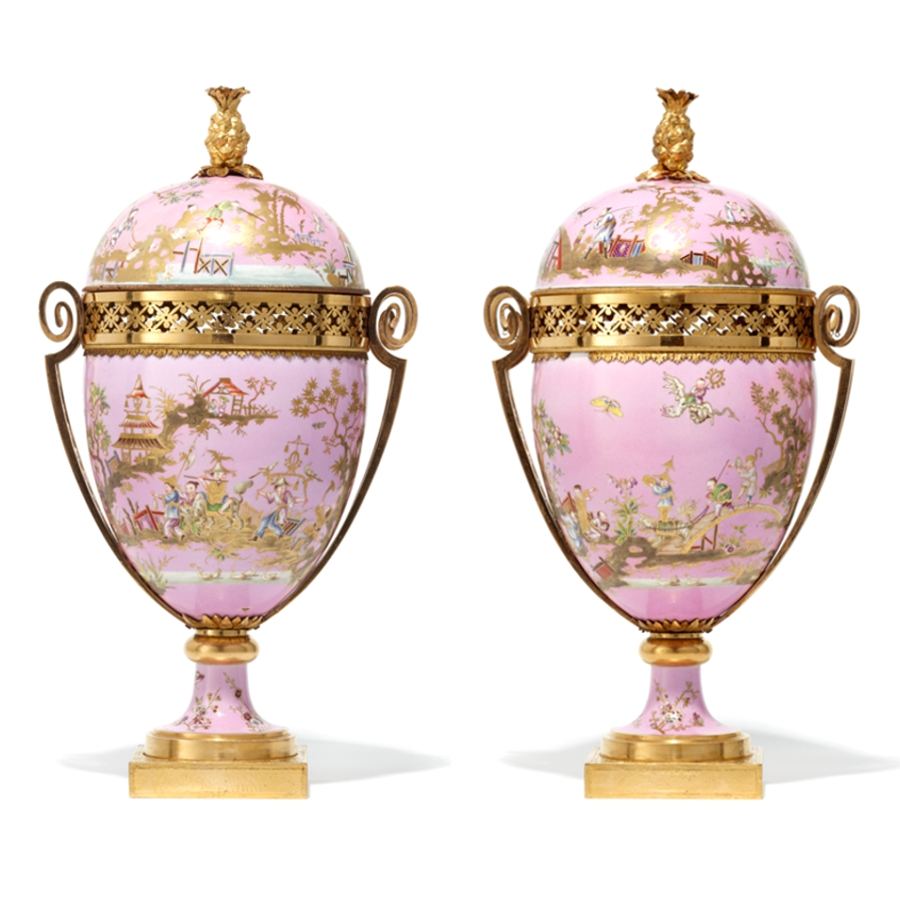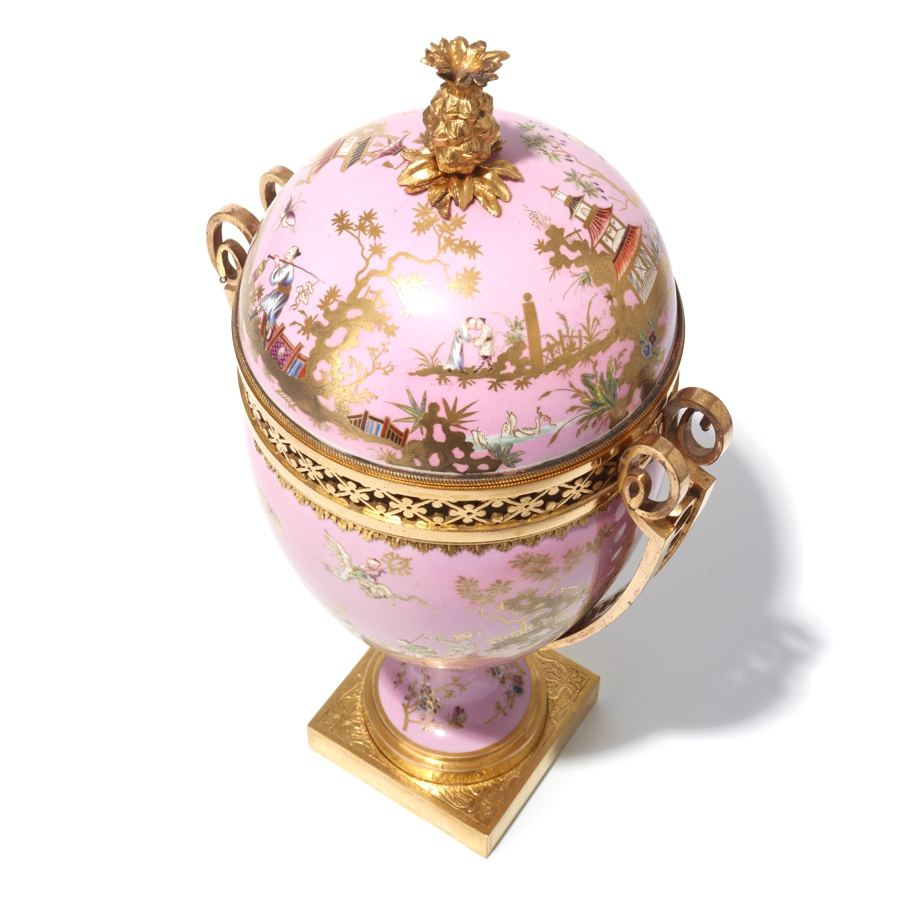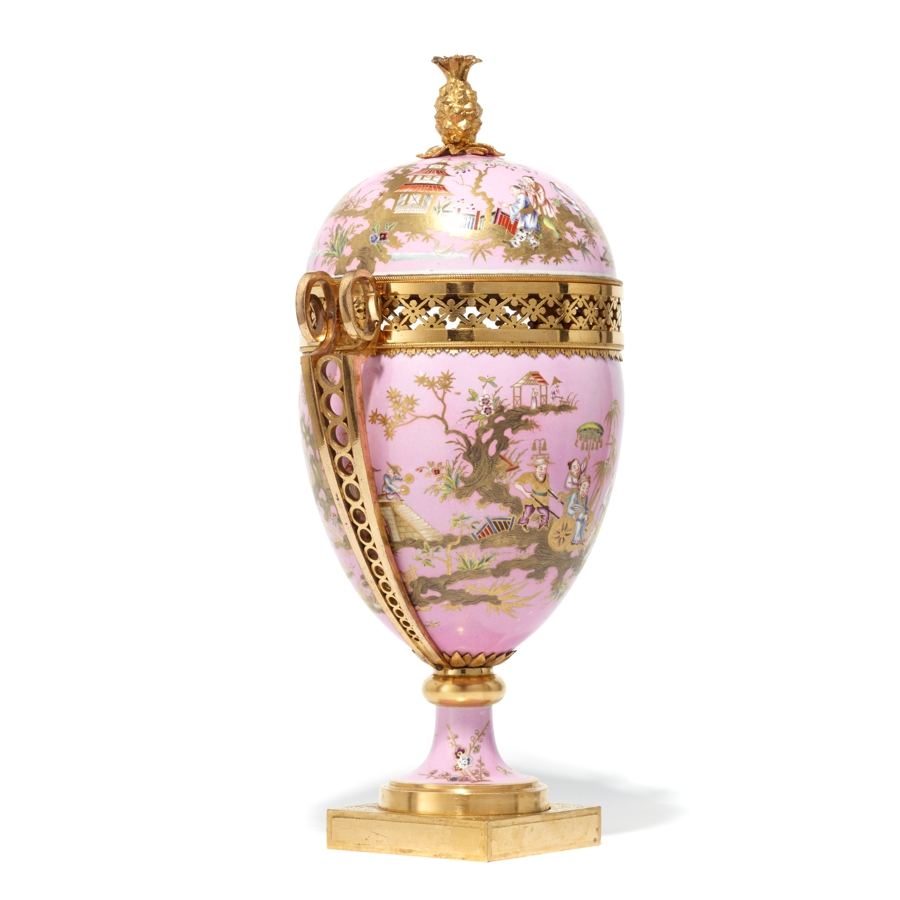Acquired by a Rusian private collector;
Subsequently exhibited in the Château de Versailles,
La Chine à Versailles, Art et Diplomatie au XVIIe Siècle, 2014
These exceptional and stunning vases are of hard-paste porcelain made at the Manufacture Royale de Porcelaine at Sèvres. The model is described in the surviving factory archives as vase oeuf à monter (‘egg vase to be mounted’). The present examples are of the second size. The extremely rare ground colour is a soft lilac-pink. It is entirely covered with exquisite and very elaborate scenes of numerous Chinese figures engaged in all kinds of outdoor pursuits, accompanied by mythical beasts, birds and insects. This decoration is finely executed in translucent enamels and yellow, pink and green tones of gilding (sometimes overlaid with a bronzing wash). The very finely worked ormolu mounts are original and were specifically designed for these vases.
Marks
The mount comes easily off only one foot. The mark under it is painted in iron-red with the factory mark (interlaced Ls), the date-letters ‘BB’ for 1779 and the personal mark of the Sèvres painter and gilder Jean-Jacques DIEU.
Overall height
15 3/8 inches (39 cm).
Porcelain
Excellent condition, except for one cover which has been broken in several pieces and restored with no loss of porcelain (this can be easily checked as the underside of that cover has not been over-painted).
Gilt-Bronze
Two or three small bells are now missing from the top volutes of the handles. Loss of two small acanthus leaves below the openwork band.

Reverse sides of the vases
The matching vase in Russia
Only one surviving vase with the same ground colour exists. It is of the same model but larger (of the first size) and with identical decoration and mounts. The archives at the Sèvres factory prove that it is in fact the central vase of what was originally a three-piece garniture.

The matching vase in the Hermitage Museum, Saint-Petersburg
(from the Yusupov collection)
Previous page and above : Description of the vase in the Hermitage Museum
(La Porcelaine de Sèvres du XVIIIe siècle, catalogue de la collection, Saint-Petersburg, 2005, pages 93-94)
The factory archives only mention one garniture of lilac-pink ground egg vases. In the register of the Travaux des peintres (painters’ work), Jean-Jacques DIEU is recorded as having decorated in 1779 : 1 Garniture de Vases oeuf en lila de trois Vases with Sujets très Riches en Chinois, for which he was paid 288 livres (Sèvres, Cité de la Céramique, archives, registre Vj’1, folio 119vo). He obviously did not have time to do all this work during his regular time because he is also recorded as working on these vases in his overtime, in the register of Travaux Extraordinaires (extraordinary work) : 1 Garniture de Trois Vases oeufs en lila… 288 livres livres (Sèvres, Cité de la Céramique, archives, série F4, année 1779).
The provenance of the Hermitage vase is given in their catalogue of 18th century Sèvres porcelain and in an article in L’Estampille – l’Objet d’Art (N°382, juillet-août 2003, pages 69-73) as the collection of the princes Yusupov. Prince Nikolai Borisovich Yusupov (1751-1831) was an avid collector of porcelain and purchased a complete service directly from the Sèvres factory in 1784. His garniture of pink ground egg-vases is not traceable in the Sèvres sales records but it is quite possible that he purchased it already in the 18th century, either for cash or through an agent. Interestingly, he was so keen on porcelain that he was made director of the imperial porcelain factory in Saint-Petersburg and later founded his personal porcelain manufactory outside Moscow.
The present owners of the pair of vases described here are a private German family who acquired them in Switzerland at Galerie Stuker, Bern, in the sale by auction of a Grosse Kunstsammlung aus hochadeligem Besitz (‘large collection of art from high aristocracy’), 19.11.1970, lot 2841. Obviously, the vases had been sold by the Soviets in the late 1920s or early 1930s along many paintings and important works of art from the Hermitage and other Russian museums, which are now in leading institutions and private collections around the world.
Although the garniture of three pink ground egg vases is unique, three pairs with white ground and different mounts were produced a little earlier, in 1775-1776. The most famous one was purchased by Queen Marie-Antoinette and is now at the Château de Versailles.
It is interesting to note that the central vase of the Marie-Antoinette garniture is dated one year later (1776) than the side vases (1775), just like the Hermitage Museum vase is dated 1780 whereas the vases here described are dated 1779. This is simply because the manufacture and decoration of such elaborate garnitures of vases was long and time-consuming and often took place over parts of two adjoining years.
The decoration on the Marie-Antoinette garniture was executed by Louis-François L’ECOT who composed simple scenes with fewer and larger figures. The decoration on the Yusupov garniture under discussion is by Jean-Jacques DIEU who preferred more elegant and lighter scenes inhabited by many more figures and animals engaged in all kinds of bizarre occupations.
The gilt-bronze mounts on all the egg vase garnitures, and also on all mounted Sèvres porcelain of the time, are attributed to the bronzier Jean-Claude-Thomas DUPLESSIS fils, who was the Sèvres appointed gilt-bronze manufacturer until his death in 1783.
Another garniture of egg vases, this time with simulated lapis ground and no other decoration, was manufactured in 1780 and purchased in 1782 for the future Tsarina Maria-Feodorovna. They are now at the Pavlovsk Palace (see below). These vases have the same whimsical pineapple knops to the covers as the Ysuspov garniture discussed here.


